Portion Sizes Around the World: Comparing Serving Sizes in France, Germany, UK and US

Every country has its own customs and cultures, and that applies to nearly everything people do and say on a daily basis – from language and housing to how we interact with one another. But it doesn't stop there. Food is a huge facet of culture no matter where you’re from. While most locales have their own unique dishes, there are plenty of instances of the same type of dish being served in many different countries, and this leads to many interesting observations.
What may seem like a typical dish in England, for example, may be served a little differently around the world. You’ll notice there are tweaks to portion sizes, side items, and sizes of side dishes that make each truly unique to the country where it’s found. To explore these differences, we took pictures of standard meals in England, France, Germany, and the United States. Keep reading to see how the same meal can vary across these countries.
Fish and chips
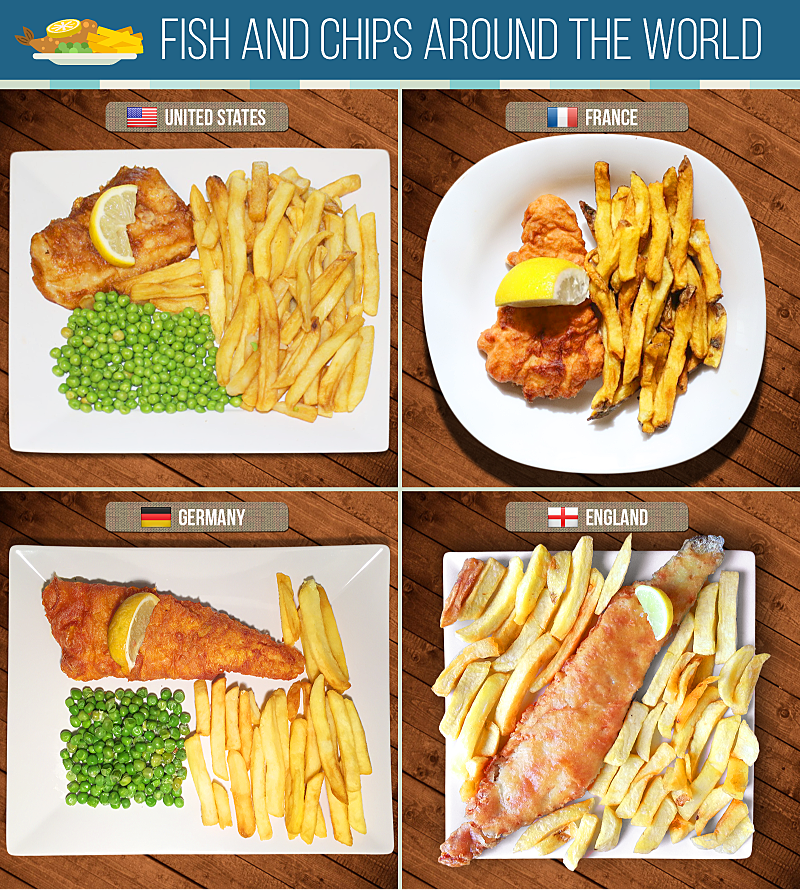
The collection of dishes here show a few differences in what is considered to be traditional British fare.
- The U.S. meal has a fish that takes up about a quarter of the plate, with a mountain of chips and a serving of peas (perhaps for good measure).
- The English dish does not include peas, which would have contributed to the dietary recommendation of 400 grammes of fruits and vegetables in the U.K.
- Germany’s version is slightly similar to the U.S., only with more fish and fewer chips. However, its dietary recommendations call for only 150 to 220 grammes of fish in a week.
- With a plate full of protein and carbs,, the French version of fish and chips reflects its recommendation of starches with every meal and protein of up to 1,400 grammes a week.
At a quick glance, the U.S. version is definitely laden with more carbs ; half of its plate is taken up by potatoes, and then there’s just a quarter left for peas. The protein offered there is meagre, comparatively, especially when it’s juxtaposed with platters from other areas that have more substantial cuts of fish.
Schnitzel
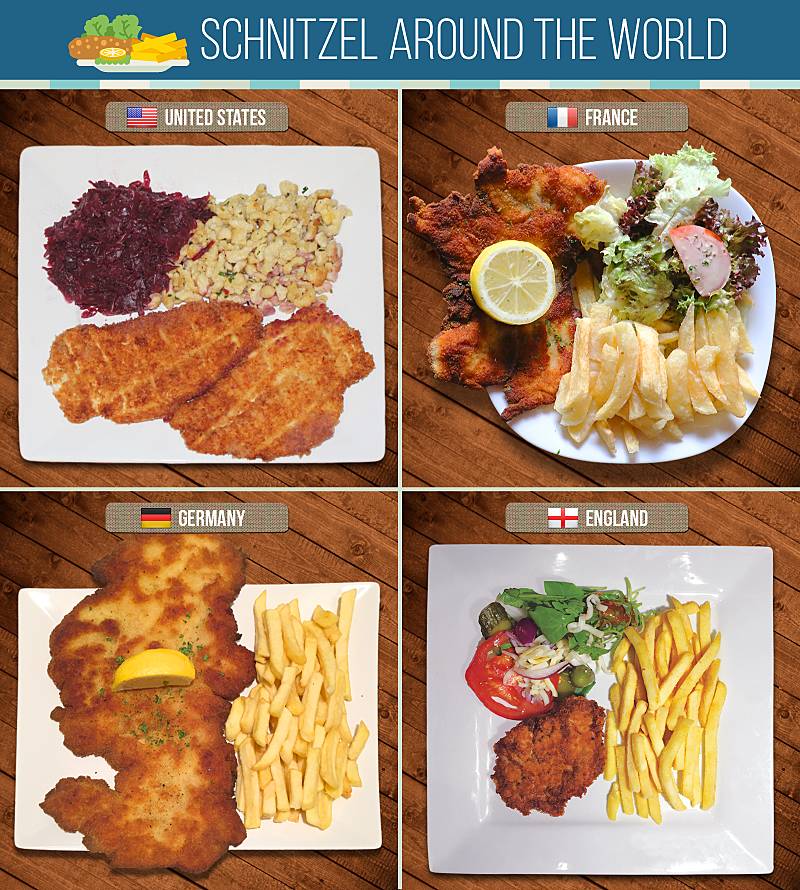
One glance at this image and you’ll see the schnitzel that one can get in Germany is enormous compared with the other countries pictured here. While the notion of thin, tenderised, breaded-and-fried meat is not exclusive to Germany or Austria, the recipe was certainly popularised in the area, and it’s a common menu item in German restaurants around the world.
- The German schnitzel dwarfs those from other countries, likely a testament to the dish’s extreme popularity in that country. In addition, this is the only plate not to be served with vegetables, which goes against Germany’s recommended daily serving of 400 grammes.
- In the U.S., while the meat portion is still rather large, other sides make up about half of the plate. With two pieces of protein in this dish, the serving goes beyond the recommended protein portion allotted to Americans.
- In France, protein takes up about a third of the plate, while the chips seem like more of an afterthought. France recommends a serving of starch with each meal, so servings are smaller.
- In England, the meat portion is the smallest. Together, the chips and salad make up almost 75 percent of the plate, which is on par with England’s daily recommendation of fruits, vegetables, and starches.
Cheeseburger
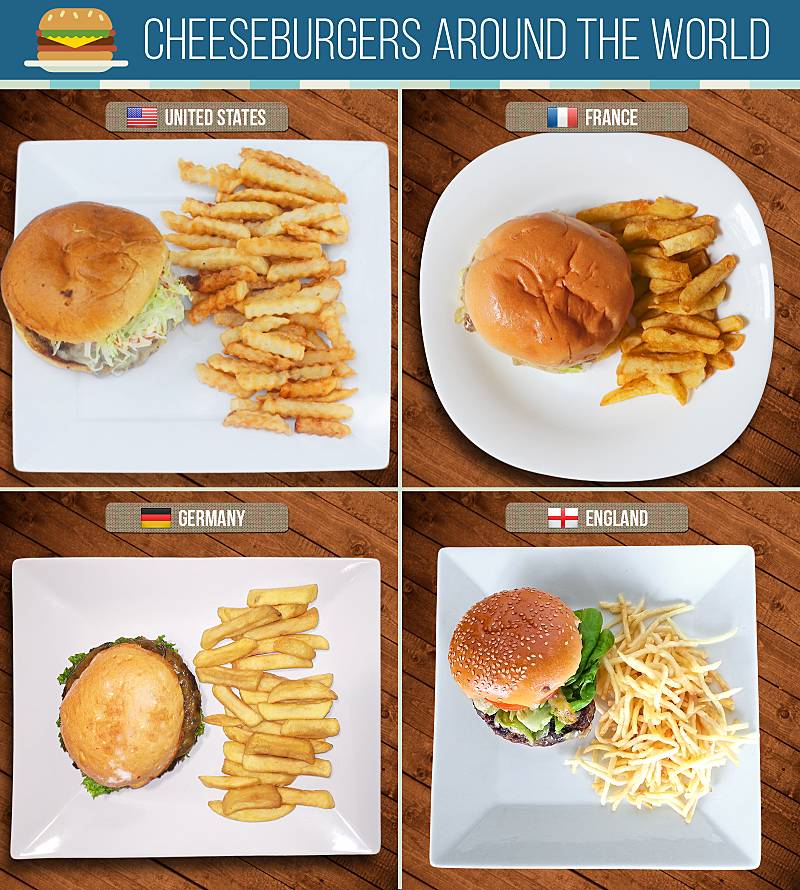
Cheeseburgers may be an American staple, but that doesn't mean the meal is exclusive to the U.S. Now an iconic part of cuisines around the world, it seems that burgers don’t vary as wildly as one may think. Since making its way onto every major chain menu, cheeseburgers have stayed somewhat classic in their style, preparation, and presentation. It seems those who indulge in this staple are all looking for a similar experience, despite where they may be ordering it from.
One difference seen is among the chips on each of the plates.
- Germany and France have smaller portions of chips, which fall in line with the limited serving suggestion of oils and fats in both countries.
- In England, the chips are much thinner than in the other countries, but actually contain a higher fat content as the surface area for fat absorption is greater.
Croque-monsieur
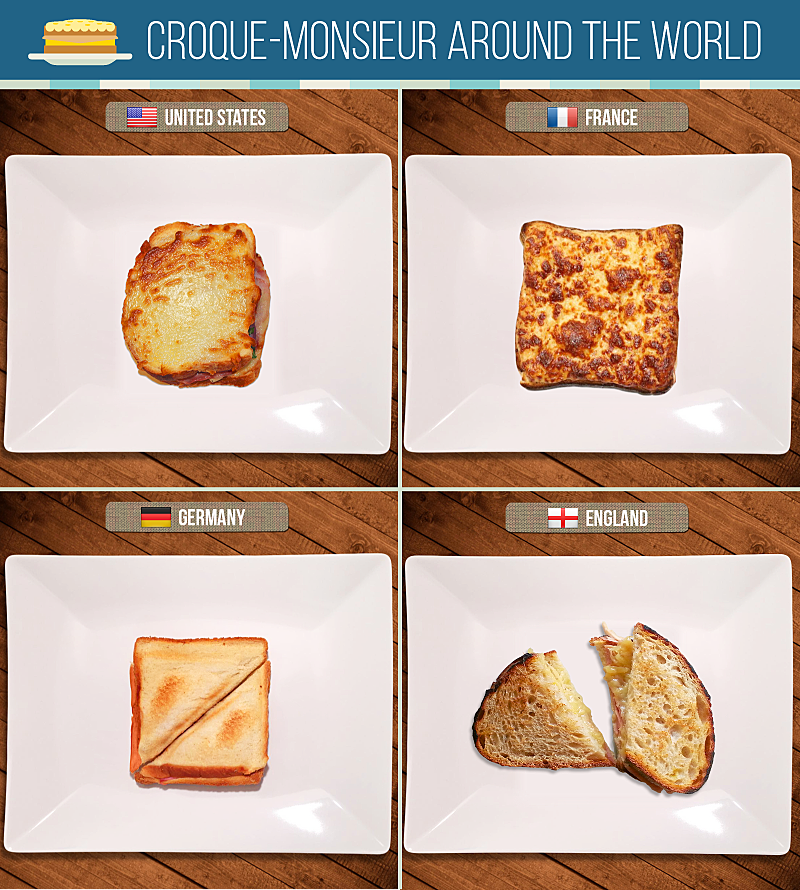
The croque-monsieur is another traditional menu staple, only this time its origins are firmly rooted in the cafes of France. The cheesy, ham-filled delicacy is prepared differently across the World. Although presentation of this main dish varies, one thing that remains consistent, especially in the dishes pictured, is the vastness of white porcelain. Served without any side dishes, this staple is not much of a balanced meal, which is completely inconsistent with the nutritional advice of these countries. This simple staple leaves room for only a few variations of ingredients and presentation from country to country.
- The classic French version usually consists of thinly sliced ham and either Gruyère or Emmental cheese. It’s often topped with a béchamel sauce and placed under the grill until toasted to perfection.
- The croque-monsieur in the U.S. looks similar to its French counterpart, although the bread is thicker.
- The German and English versions both seem unique. The German sandwich looks like a typical toasted ham and cheese sandwich, as does the English meal; however, the latter uses nice big slices of bread.
U.S. serving sizes
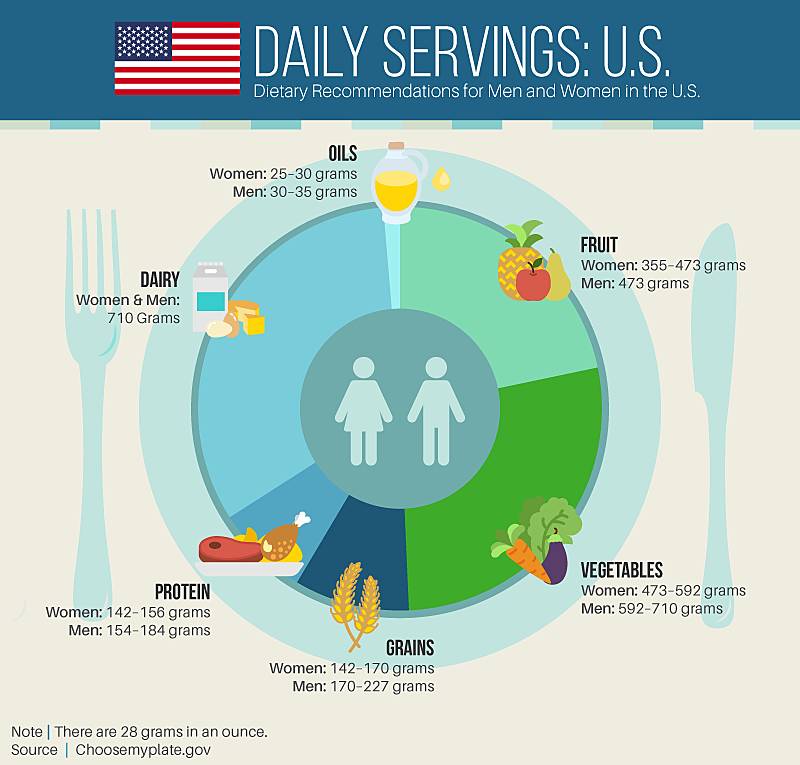
Instead of the classic food pyramid of old, the U.S. now features a programme called MyPlate, which highlights where the focus should be at each meal. As illustrated here, the typical American diet should consist of about 50 percent fruits and veggies, with smaller portions allotted to dairy, grains, and protein.
Compared with other recommended diets around the globe, the U.S. only recommends a small amount of protein, especially relative to the amount of produce recommended. This is most apparent in the photo of the fish and chips dish above, where only a quarter of the meal is made up of protein.
U.K. serving sizes
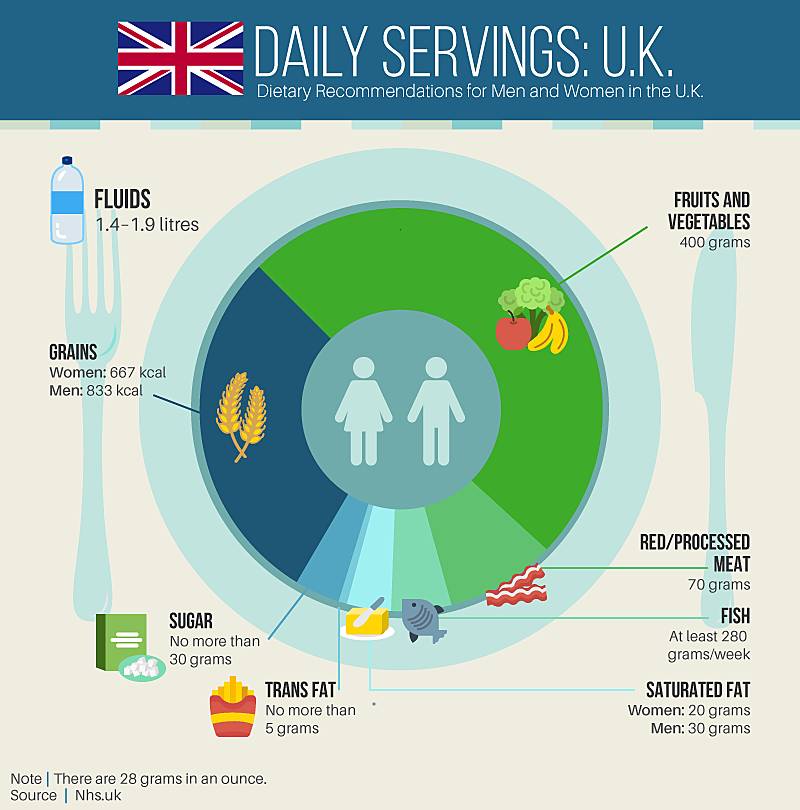
Much like the U.S., the U.K. recommends that about 50 percent of daily diets consist of fruits and vegetables. The 5 A DAY plan, recommended by the National Health Service (NHS), emphasises the importance of getting five 80-gramme portions of fruits and vegetables a day (and it’s probably part of the reason England’s cheeseburger is stuffed full of leafy goodness). England also makes veggies a prominent part of its schnitzel offering, making it more of a complete meal.
You’ll also notice a fair chunk of dark blue. This indicates grains, and it’s reflected by the hefty bun on the cheeseburger and the bread on the croque-monsieur. Unlike the U.S., the NHS recommends that meals in the U.K. should be based on starchy foods, which provide fibre and vitamins, and should make up a bit over one-third of everything consumed on a daily basis. Comparatively, both countries agree that of all grains and starches consumed, should be chosen from whole-grain or wholemeal varieties to provide higher levels of vitamins and fibre.
Germany serving sizes
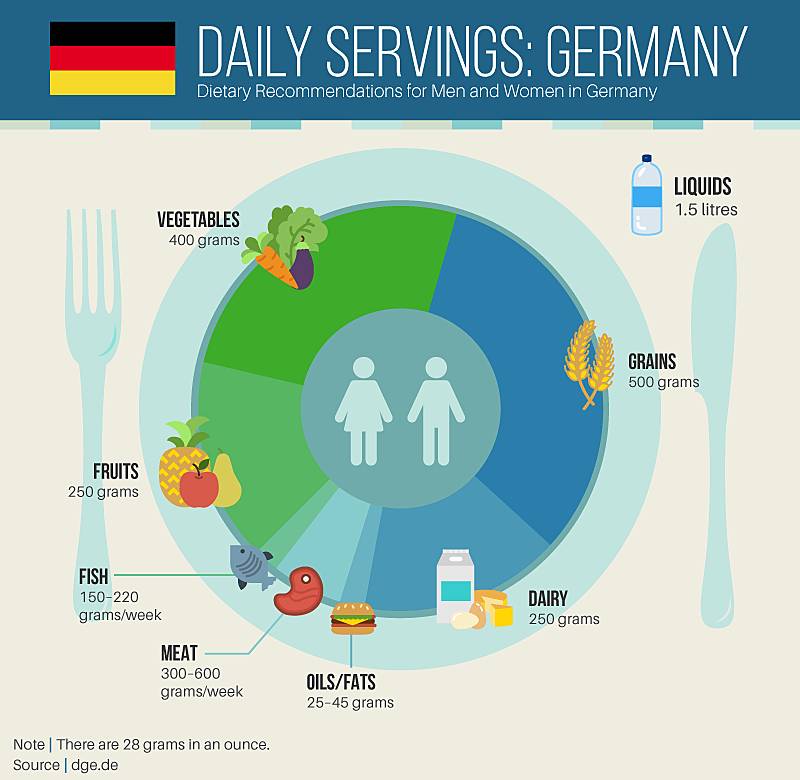
Germany also prominently features grains as well as fruits and veggies. Additionally, Germany recommends a small allotment of fish weekly (150 to 220 grammes), a fact that is certainly reflected in the fish and chips meal above. While Germany doesn’t necessarily have a huge portion cut out for daily recommended meat, their servings don’t seem to reflect that – particularly in their version of schnitzel.
France serving sizes
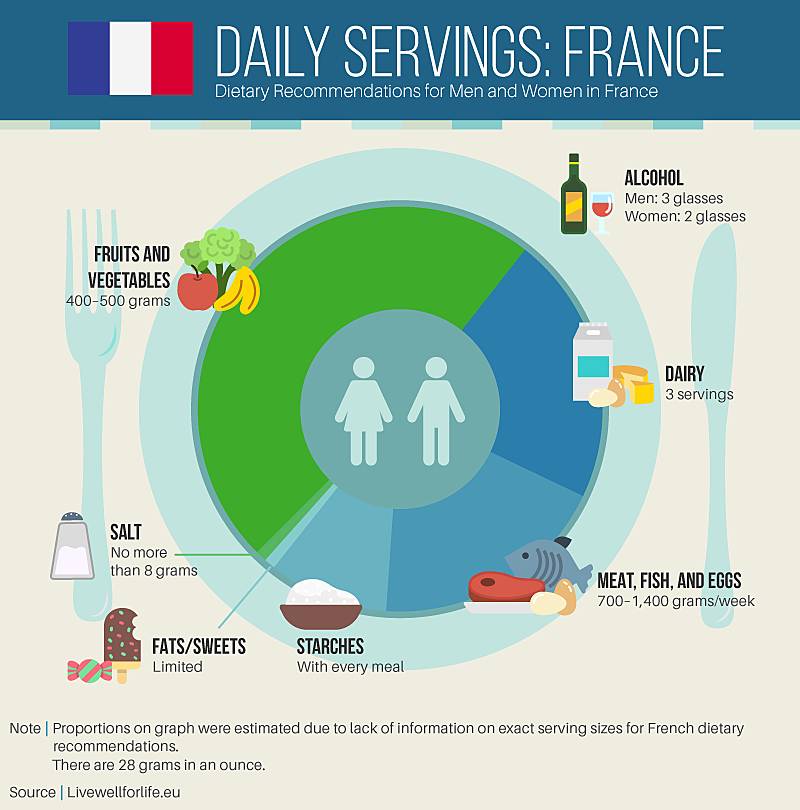
The French daily recommendations are a bit different. Not because they have a huge chunk for fruits and veggies, but because they encourage their citizens to eat plenty of fish. French folk are urged to eat around 100 to 200 grammes each day. These numbers may be a reflection of the fact that the Mediterranean diet is known for encouraging heart-healthy choices, including the consumption of fish. This is likely one of the reasons France’s fish and chips features a fairly hearty portion of seafood.
France’s liquid diet also looks quite different. France is the only country analyzed that included a daily intake of alcohol as part of its daily dietary recommendations. The U.K. and Germany each recommended a daily intake of liquids of about 1.5 liters, which can include water, coffee, tea, fruit juice, smoothies, and other low-sugar drinks. Alcohol intake was not included on the MyPlate dietary recommendations for the U.S., but the website mentioned that one drink for women and two drinks for men are considered accepted daily moderation. France ups that moderation, recommending up to two glasses a day for women and three for men. Cheers, France!
Calories in, calories out
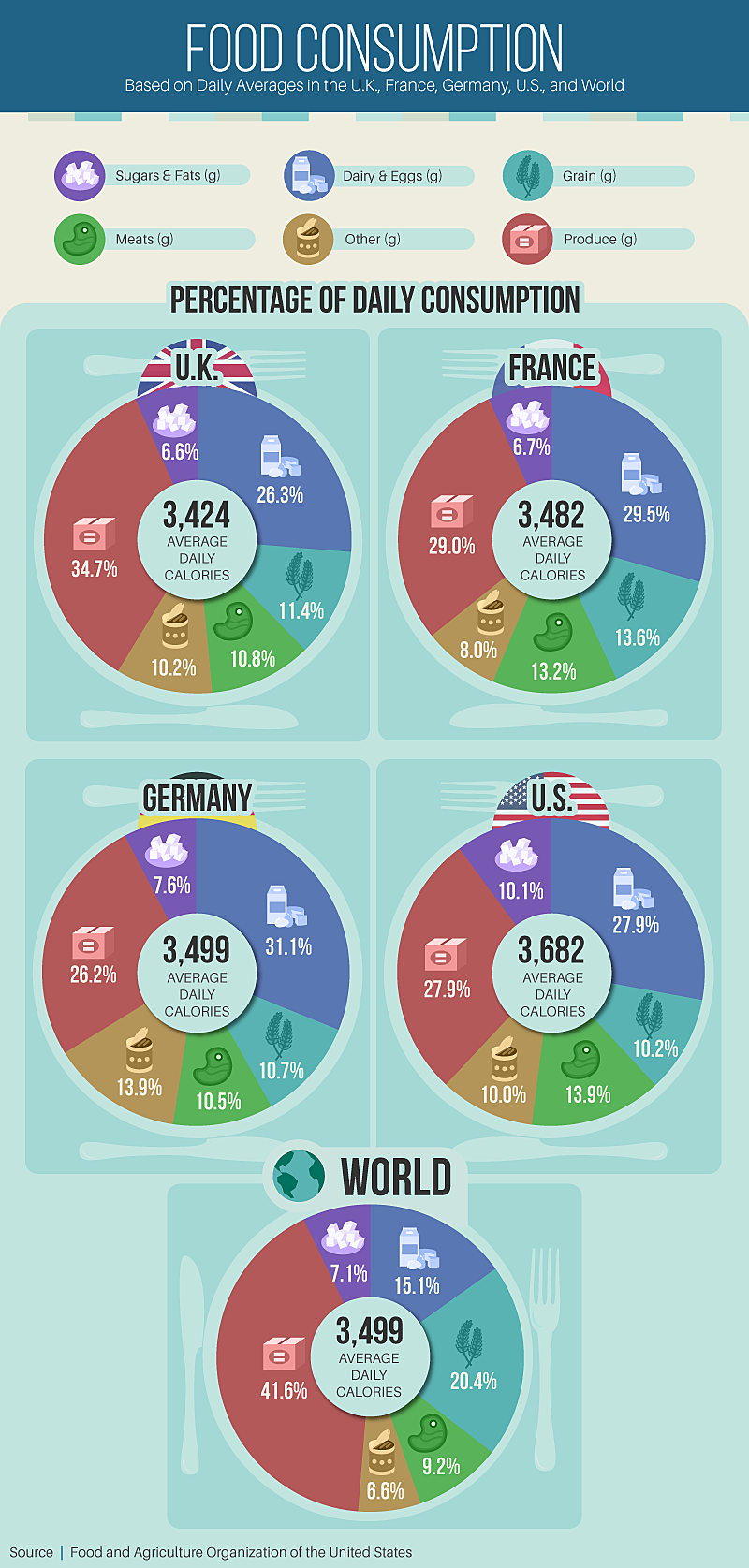
Finally, let’s consider the basic food groups and their combined caloric totals for actual consumption, by nation.
Because as we all know, what we should eat and what we do eat are two very different things.
Caloric recommendations vary by gender and individual, but the standard remains: 2,000 calories per day for adults. In the chart above, the world average shows a 36 percent caloric difference (2,884 calories) from the daily recommended value. The highest average, found in the U.S., stands at a 59 percent difference (3,682 calories).
These numbers may seem negative, and for some individuals, they could adversely impact their health. However, the data show these nations may still have quality on their side. The conventional wisdom when it comes to diet and exercise has mostly remained “calories in, calories out.” That is: To lose weight or maintain, we must burn our fuel; otherwise, it stays in the tank – and that fuel becomes, well, fat. But doctors are still learning more about food and its impact on health and weight loss.
Some researchers now maintain food quality is just as important, if not more, than quantity – especially when it comes to carbohydrates. At least a quarter or more of all consumption for each country and nearly half of the world total comes from produce.
Conclusion
Staying healthy can be a challenge, especially as we’re often on the go and feel like takeaway is our only option. If you must eat out, remember: Quality matters. Load up your plate with low-calorie, high-nutrient veggies no matter which dining table you’ve bellied up to.
At ZAVA, we think it’s important to maintain a healthy lifestyle. If you have any questions or concerns, our online doctors are available to help and find suitable treatments in many aspects of your health. If you have difficulties maintaining your weight or trying to lose weight, you might benefit from the weight loss treatment prescribed by our doctors. Our team is here to support you at every stage of your weight loss journey. Message a doctor for free, confidential advice through your account.
Visit zavamed.com today to learn more and take your health into your own hands.
Methodology
We had researchers in Germany, England, France, and the United States take pictures of foods that were typical of each country. All meals came from similar types of restaurants, and all fell under the same price ranges for their category. Serving recommendations for each country were converted to daily recommended grams.
Fair use
Feel free to share, repost and discuss the images and results found on this page freely. When doing so, we ask that you attribute the creators by linking to zavamed.com and providing your readers with a link to this page, so that they may learn more about this research and access all available assets.
Explore ZAVA services
| Service | Treatment | |
|---|---|---|
| Men's health | ||
| Women's Health | Microgynon, Cerelle pill, Cerazette, Yasmin pill, Lucette, Rigevidon, Cilique, Evra patch |
|
| General Health | ||
| Sexual Health | ||
Genital Chlamydia and Gonorrhoea Test, Oral Chlamydia and Gonorrhoea Test, Extended STI Test, Chlamydia Test, HIV Test, HPV Test |
||
| Chronic Health | ||
Atorvastatin, Simvastatin, Rosuvastatin, Cholesterol Test Kit |
||
| Travel Health | ||